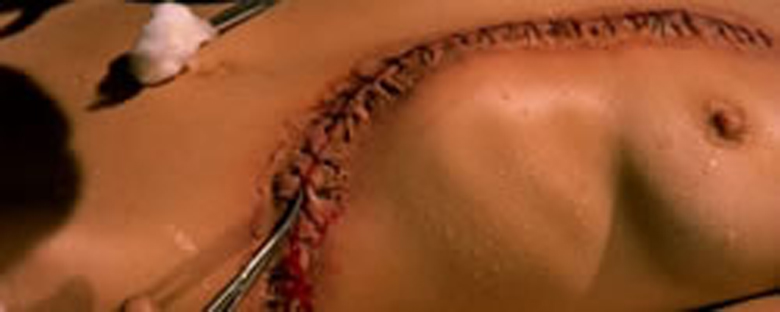Reviews
Andy Warhol’s Frankenstein
Paul Morrissey and Antonio Margheriti (as Anthony Dawson)
USA / Italy / France, 1973
Credits
Review by Leo Goldsmith
Posted on 18 October 2005
Source Image Entertainment DVD
Related articles
Features: 31 Days of Horror
Reviews: Frankenstein
Reviews: Bride of Frankenstein
Reviews: The Curse of Frankenstein
Reviews: Re-Animator
In the opening shot of Flesh for Frankenstein, we see Baron Frankenstein’s son and daughter wandering around their father’s laboratory, eyeing rats in cages and fish in aquariums. Wordlessly, they pick up a doll and begin to dissect it with a pair of scalpels, slicing open its chest and pulling out its white, cotton insides. Next, the boy sets the mangled doll upon a miniature guillotine and, pulling the lever, severs the doll’s head. A small but noticeable stream of blood spurts from the doll’s wound.
In discussing Christopher Lee’s performance in The Curse of Frankenstein, I noted the actor’s emphasis on the Monster as an assemblage of parts, of limbs working almost independently, and the observation that he moves like a broken puppet. In Flesh for Frankenstein, this resemblance of Frankenstein’s creation as a deformed toy is carried over into the bleeding, decapitated doll, a creature that also ambiguously bridges the animate and the inanimate.
This ambiguity of the animate and the inanimate is closely aligned with Freud’s notion of the uncanny. In his famous essay, Freud takes from Ernst Jentsch the notion that the uncanny is often located in “doubts [as to] whether an apparently animate being is really alive; or conversely, whether a lifeless object might not be in fact animate.” Jentsch cites such examples as “waxwork figures, ingeniously constructed dolls and automata,” as well as “the uncanny effect of epileptic fits, and of manifestations of insanity, because these excite in the spectator the impression of automatic, mechanical processes at work behind the ‘ordinary appearance’ of mental activity.” To this taxonomy of the uncanny, Flesh for Frankenstein adds the anaesthetized patient during surgery and the pervert in the throes of sexual ecstasy. And it adds both of these in the same scene.
Morrissey’s grotesque, ravishing film situates the Frankenstein story squarely in the world of the Freudian uncanny. The film first introduces us to the Baron’s mute, zombie-like children, who play with mechanical horses and birds, as well as their father’s surgical instruments, in their bizarrely furnished (Gothic meets Klimt) nursery. They live in silent obedience under the controlling hand of their mother (who is also the Baron’s sister) and her fascistic dedication to beauty. (“I have always looked for beauty. As a matter of fact, I insist on it.”) And as Frankenstein’s wife-sister manufactures their perfect, little children, the doctor and his deferent assistant, Otto, spend all their time in their laboratory manufacturing the first specimens of a master race of “Serbians.”
It is notable that most adaptations of Frankenstein portray the doctor as a man whose dedication to science and lust for professional glory take him too far. In Flesh for Frankenstein, the Baron (played by the infectiously demented Udo Kier) is just looking to rule the world by creating a new species of human that will obey his every whim. Frankenstein is disgusted by sex between “ordinary” humans; so, instead he assembles perfect creations in his laboratory — a man and a woman — that will procreate for him. “Ze true start of a new race, entirely created by me!” But when the Baron brings his ersatz Adam and Eve to the dinner table to meet his family — “Look how natural they are!” — they are rigid automatons, resembling nothing so much as Hans Christian Andersen’s tin soldiers, or even the Baron’s own biological children.
In his essay, Freud makes particular note of the confusion of linguistic definitions of the uncanny, which seem to identify it as something at once familiar and unfamiliar. In this way, Freud relates the experience of the uncanny to the return of repressed memories and desires. This is a familiar notion in the Frankenstein story, as it is so often the spectral presence of the monster’s previous life (usually as a particularly violent criminal; in Flesh, as a homosexual) that causes the undoing of the doctor’s master plan. Flesh for Frankenstein, as an uncanny text, hinges upon the perverse confusion of the familiar and the unfamiliar, life and death, the operating room and the bedroom. The film proposes a number of variations on the blending of sex, surgery, and (curiously) digestion: even the German cast members’ pronunciation seems to turn Frankenstein’s “laboratory” into his “lavatory.” In the film’s most memorable scene, Frankenstein ecstatically explores the inner organs of the cadaver of his female Creature and then — purportedly to “know death” — fucks her in the gall bladder. Interestingly, this action seems to engender a sexual ecstasy that rouses the patient from her slumber, even though she has not yet been reanimated by the Baron’s electrical process, making possible the enjoyment of perversion even in death.
We don’t do comments anymore, but you may contact us here or find us on Twitter or Facebook.



